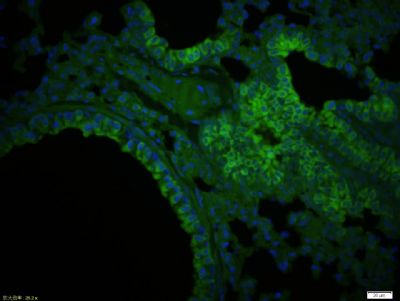Members of the C1q superfamily have diverse functions that are related to cell adhesion and basement membrane components. CTRP5 (Complement C1q tumor necrosis factor-related protein 5) is a 243 amino acid secreted and membrane-associated protein that contains a collagen-like domain and a C1q domain. CTRP5 is a short-chain collagen that is expressed in retinal pigment epithelium as well as brain, lung, liver and placenta. By forming an extracellular hexagonal lattice, CTRP5 facilitates the adhesion of basal retinal pigment epithelium to Bruch’s membrane, the innermost layer of the choroid. A mutation within the C1q domain of CTRP5 results in abnormal high molecular weight aggregate formation, which alters its structure and interactions. This mutation may result in the presentation of late-onset retinal degeneration (LORD), an autosomal dominant disorder that is characterized by punctate yellow-white deposits in the retinal fundus and night blindness.
Function:
Adipose tissue of an organism plays a major role in regulating physiologic and pathologic processes such as metabolism and immunity by producing and secreting a variety of bioactive molecules termed adipokines. One highly conserved family of adipokines is adiponectin/ACRP30 and its structural and functional paralogs, the C1q/tumor necrosis factor-alpha-related proteins (CTRPs) 1-7. Unlike adiponectin, which is expressed exclusively by differentiated adipocytes, the CTRPs are expressed in a wide variety of tissues. These proteins are thought to act mainly on liver and muscle tissue to control glucose and lipid metabolism. An analysis of the crystal structure of adiponectin revealed a structural and evolutionary link between TNF and C1q-containing proteins, suggesting that these proteins arose from a common ancestral innate immunity gene. CTRP5 has been suggested to be involved in age-related macular degeneration.
Subcellular Location:
Secreted
DISEASE:
Defects in C1QTNF5 are a cause of late-onset retinal degeneration (LORD) [MIM:605670]. LORD is an autosomal dominant disorder characterized by onset in the fifth to sixth decade with night blindness and punctate yellow-white deposits in the retinal fundus, progressing to severe central and peripheral degeneration, with choroidal neovascularization and chorioretinal atrophy.
Similarity:
Contains 1 C1q domain.
Contains 1 collagen-like domain.
SWISS:
Q9BXJ0
Gene ID:
114902
Database links:
Entrez Gene: 114902 Human
Entrez Gene: 235312 Mouse
Entrez Gene: 315598 Rat
Omim: 605670 Human
SwissProt: Q9BXJ0 Human
SwissProt: Q8K479 Mouse
SwissProt: Q5FVH0 Rat
Unigene: 632102 Human
| Picture |
Paraformaldehyde-fixed, paraffin embedded (Mouse lung); Antigen retrieval by boiling in sodium citrate buffer (pH6.0) for 15min; Blocking buffer (normal goat serum) at 37°C for 30min; Antibody incubation with (CTRP5) Polyclonal Antibody, Unconjugated (SL11717R) at 1:200 overnight at 4°C, followed by a conjugated Goat Anti-Rabbit IgG antibody (SL0295G-FITC) for 90 minutes, and DAPI for nuclei staining.
|
|
|
